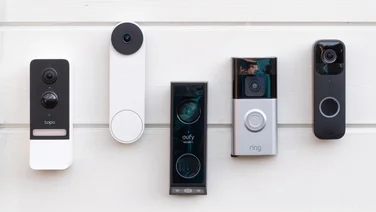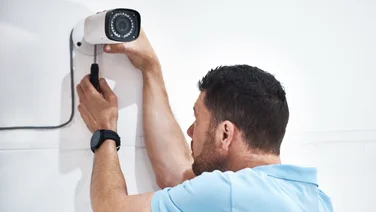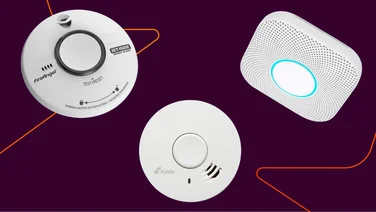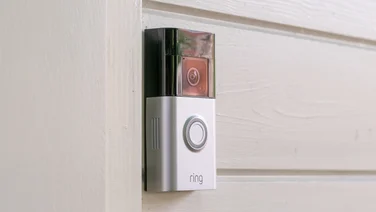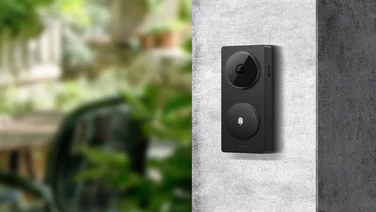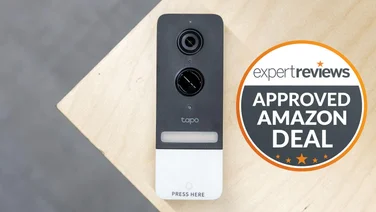To help us provide you with free impartial advice, we may earn a commission if you buy through links on our site. Learn more






- Excellent colour night vision
- Granular detection options
- Fast reaction times
- Only one strap bracket in the box
- Solar panel lacks a hanging eye
For most homeowners, the main issue with an external security camera is power. Installing a security camera on an outside wall doesn’t put much strain on an average person’s DIY skills, provided you have a drill and a set of ladders.
Getting a power supply to the said camera is rather more of a challenge, because many people, including myself, are not entirely comfortable messing with mains electrical wiring or knocking holes through external walls.
A solar-powered camera is an elegant solution to this problem because it removes the need for any connection to a domestic power supply. Just mount the camera and solar panel, connect the two, then stand back, safe in the knowledge that no one is going to get electrocuted and you haven’t damaged your weatherproofing.
That’s where gadgets like Reolink’s new Altas camera come in. For under £140, it’s a one-box solution to external security monitoring that doesn’t require a builder or a sparky to install.
What do you get for the money?
Reolink bundles everything you need to get your camera up and running, including a 2.5K camera module with a 20,000mAh built-in battery, a 6W solar panel, and all the necessary brackets, mounts, templates, screws, raw plugs, and other accessories required for installation.
For those truly allergic to DIY, Reolink bundles a couple of nylon straps and an adapter bracket so you can mount the camera or solar panel on a drain pipe, a pole or a tree of small girth, although oddly, there’s only one in the box.
The solar panel does come with a 4m cable, so you’ve plenty of scope to place the panel away from the camera as architecture dictates. However, this cable is hard-wired at the solar panel end, so if it ever comes loose after being hit by a tree branch on a windy day, or is nibbled by wildlife, you’ll need to buy a whole new panel for £40
The “bullet” camera module is finished in grey and white plastic, weighs 554g and measures 126 x 78 x 76mm. The solar panel weighs 27g with a surface area of 174 x 210mm, and the mounting arm is 185mm long, which gives plenty of scope to place it away from eaves or anything else that casts a shadow. It’s a shame there isn’t a simple eye to hang it off a nail or hook, a solution that would be ideal for my yard.






The camera itself is well-specified, with a 1/1.8″ CMOS sensor capable of capturing 2,560 x 1,440 resolution video at 15fps. There’s an adjustable Wi-Fi antenna at the top of the unit, while above the lens and PIR detector, a row of six white LEDs provides lighting.
The camera has a built-in siren – I measured this at a loud 96dBA – and two-way audio, should you need to hear as well as see what’s afoot and then yell at someone or something.
It’s also IP66 rated, which means it’s dust-tight and protected against powerful water jets or driving rain, although the solar panel is only rated at IP55. Plus, there’s a microSD slot hidden behind a rubber bung at the rear of the camera, which supports local video clip recording.
You can take out a cloud storage subscription if you want off-site storage. That will set you back either £3.49 per month for 5 cameras and 30GB of storage, or £6.89 for 8 cameras and 80GB.






But you’re not forced to do this. In fact, the only feature you’ll miss out on if you don’t take the subscription is rich (i.e. with pictures) notifications. The rest of us get all the features we need for free, including things like continuous recording, 10-second pre-alert recording, and AI target distinction.
If you want more secure storage, that’s also a non-subscription option. Reolink sells an £80 ‘home hub’ box that works as network-attached storage for your camera, so you never have to compromise your privacy by sending video to a third-party server who knows where.
And since Reolink is a member of the ONVIF standard community, you are not limited to Reolink hubs either. TP-Link, for one, has just announced the Tapo H500 hub unit that will store recordings from multiple cameras supporting the standard.
How easy is it to set up?
The Reolink is very near the top of my list of the easiest Wi-Fi cameras to set up. Just power up the camera either via the solar panel or a USB charger, download the app, press the power button (under a weatherproof flap next to the MicroSD card slot), wait for a voice cue from the speaker and scan the QR code on the camera. Once you’ve entered your Wi-Fi password (the Reolink supports 2.4GHz and 5GHz Wi-Fi 6), you’re done.
At no point do you need to give Reolink your e-mail address or open an account.
The Reolink mobile app is one of the better-designed camera apps I’ve used. The landing page is clean with big toggles at the bottom to enable the two-way talk function and launch the playback menu, which is itself a very straightforward linear timeline affair that also supports x.5 and x.25 slow motion playback.






Smaller buttons are situated at the top of the screen to sound the alarm, switch on the LED floodlights, open the system status and settings menu and put the video feed into Picture-in-Picture mode.
Once you’re into the video feed you’ll see a row of buttons to pause the video stream, mute the camera, take a snapshot, start a video recording, switch the feed quality and go full-screen. In other words, all the controls you regularly need are right there in front of you when you open the app.
Smart home compatibility is limited to Google Assistant and Alexa, which will leave Apple HomeKit users feeling left out, and there’s obviously no support for Matter as the standard doesn’t yet support cameras.
Turning to the physical side of things, I found the various brackets and mounting arms to be well-designed and solid. And once up on the wall, both the camera module and the solar panel are secured in place with ball-and-socket mounts, which makes them easy to remove and offers a wide range of directional adjustability.
What does it do well?
The Reolink Altas handles its main task of relaying quality video with impressive competency. The video feed looks crisp and colourful, whether you’re running in High (native) or Fluent (720p) modes. Reolink suggests you stick to the latter over 2.4GHz Wi-Fi, but I found that High worked well no matter what signal I was connected to.
The lens has a usefully wide angle of capture covering 110 degrees diagonal or 90 degrees horizontal and 50 degrees vertical. There’s no distortion to be seen at the edges of the image. Unusually, the camera doesn’t support infrared night vision, but that’s not an issue because the colour nighttime images are very bright and detailed, thanks to the camera’s five bright LEDs.
Indeed, so good are night-time images that, unless you live in a rural area where the nights are truly black, you’ll be pushed at first glance to tell if a capture was taken during the hours of daylight or night.
If, like me, you live in an urban or suburban environment with anything in the way of street lighting, you may never see the LED lights come on automatically. In fact, I had to move the camera indoors to create an environment in which the ambient light was low enough the camera needed lights, but I’d say they put out enough illumination to light up a 3 x 6m garden or yard.






I was most impressed, however, by the granular level of control the app gives you over the camera’s detection settings.
As is usual for outdoor security cameras, you can adjust the sensitivity of the PIR sensor and create zones the sensor will ignore, but you can also adjust both those settings separately for people, vehicles, animals and anything that doesn’t fall into one of those three categories.
Taking things one step further, you can also adjust the size of objects that will register detection for people, animals and vehicles. That meant I was able to set the camera to ignore my greyhound when in the yard, but detect next door’s cat and to ignore cars driving along the lane behind the house, but to register vans and lorries.
When it comes to battery life, my observations are that even in the cloudy weather typical of a British summer, the solar panel is more than capable of keeping the battery fully charged, no matter how frequently the motion detection and record features engage.
To give you an idea of how efficient it is, when I unboxed the Altas, the battery was 52% full. After around ten hours in sunlight, half of that in direct sunlight, the battery showed 100% and stayed at 100% for the rest of the testing period. For most of that time, the weather in the area I live in was cloudy and wet, and the place I had the solar panel positioned was only in what direct sunlight there was for around half the day.






During my testing, the system was set to capture and record all motion, so every time I or the dog entered the yard, it alerted and recorded, and every time a vehicle drove up the lane, ditto. I also regularly used the manual record facility and at one point sent the system to record continuously for 24 hours.
With continuous recording disabled, and the power cable disconntected, the battery showed a 5% drop every 24 hours, suggesting a 20-odd day life, but that could be extended by dialling down the sensitivity of the motion detector. I had the most sensitive settings enabled during this test.
The final positive thing to say about the Altas is that it’s very quick to respond to motion events. In my testing, alerts appeared on my phone almost instantly, which is an important feature if you want to know what’s going down in your garden or on your drive as it’s happening. It wasn’t quite so quick to launch the video itself, taking an average of four seconds from tapping the alert to seeing the action. If you add those two numbers together, though, it’s still up there as one of the faster systems around.
What could it do better?
It’s a testament to the quality of the Reolink Altas that the page of my notebook dedicated to things I didn’t like about the Altas or things that could be improved, is blank.
Granted, I’d like the camera module to be available in another colour, either black or brown or camo, the camera could shoot video in 4K rather than 2.5K, and the solar panel could use a hanging eye, but those are gripes that are peripheral at best.
I suppose I could lambast it for not supporting HomeKit, but that would seem harsh given its support for the ONVIF standard – and that fact that it works with both Alexa and Google Assistant.
Reolink Altas review: Should you buy it?
For the price, the Reolink Altas and solar panel package is difficult to criticise. It’s a reliable, simple and high-quality surveillance and security system that’s easy to set up, easy-to-use and doesn’t require any sort of subscription to get the maximum from it.
The more I use the app, the more I am coming to appreciate that someone at Reolink has given some very serious thought to the functions people use the most often and put them in an immediately accessible place. The speed and stability of the system are also highly impressive.
Unless I was limiting myself to a budget outdoor camera like the Blink Outdoor 4, which at £70 is half the price of the Reolink, then the Altas is among the cameras I’d look at first.


